Introduction
The Boomer generation is often portrayed as being in conflict with millennials. Indeed, the meme ‘Ok, Boomer’ could summarise the gulf between the priorities of those born in the decades after World War II and those born during the 1980s and 90s.
At Man Group, however, the phrase ‘OK, Boomer’ is taking on a slightly different meaning. While it might not portray what the millennials meant when the phrase was coined, US population growth and demographics trends would indicate, to us at least, that demand for single family rentals will be growing over the coming decades, and that supply may well fail to keep up. Indeed, when it comes to single family rentals, a new, different boomer generation is good news for the sector, in our view.
A Boom of Two Parts
We have a positive outlook on the single family rental (‘SFR’) sector for two main reasons: population growth and a shift in demographics.
Firstly, population growth has an obvious influence on the demand for housing. While we observe the decline in population growth in many areas across the globe, the US is forecasted to grow from a population of 319 million in 2014 to a population of 417 million by the end of 2051.1 As the population continues to grow, enough new homes need to be built to satisfy demand. However, permit issuance for the construction of new single family homes has been significantly below the historical average for much of the last decade, after reaching its peak of 1,681,986 in 2005 (Figure 1). With 858,910 permits issued in 2019, we are approaching the historical average, although the gap between population growth and new permits is still very large (Figure 2).
Figure 1. Single Family Home Building Permit Issuance
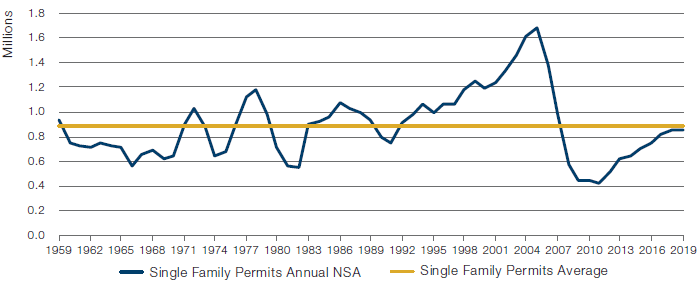
Source: US Census Bureau; as at 31 December 2019.
Figure 2. Single Family Home Building Permits Versus US Population Growth
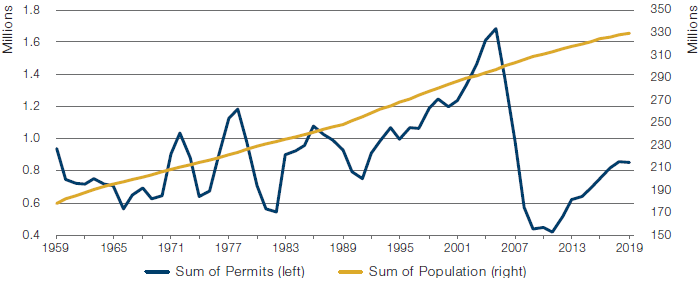
Source: US Census Bureau; as at 31 December 2019.
We expect this shortage of new homes to support continued home price appreciation over the medium term, leading to an ever greater cost of entry and therefore supporting strong rental occupancy as prospective buyers are priced out of the market.
Furthermore, Figure 3 shows that occupancy numbers are hovering around the historical average of 94.3%, but are still well below the all-time high of 97.1% in 1978 – the peak period of household formation by the baby boomer generation. For comparison, the occupancy rate in the first quarter of 2007 – the peak of the housing boom in the US – was a mere 89.7%. In our view, this is supportive of SFR – as the occupancy rate has increased and new construction has slowed, the pool of available homes has contracted. A high occupancy rate, all else being equal, should be supportive of rental prices – and while we are around the long-term average, the lack of ongoing construction should support further rental price growth.
Figure 3. US Occupancy Rate
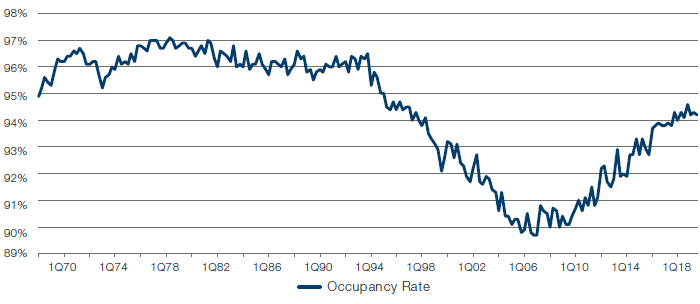
Source: US Census Bureau; as at 30 September 2019.
While population growth provides a tailwind for the SFR sector, a larger impact on household formation is anticipated by the shift in current demographics. There has been a tendency for Americans to delay major milestones such as getting married and having children. The average age for first marriage has risen – from 23.2 years for men and 20.8 for women in 1970, to 29.8 and 28.0, respectively, in 2019.2 Likewise, the percentage of 30-year olds who are married with children (the prime demographic for the purchase of single family homes) has declined, even as the overall population increases. In 1975, almost 90% of 30-year olds were married and about three-quarters lived with a child, while in 2015, only 57% of 30-year olds were married and less than 50% lived with a child (Figure 4).
However, it is important to note that we haven’t seen a decline in the total number of Americans in this age bracket. As Figure 5 shows, about 23 million Americans are aged 26-34. This large cohort – which has delayed marriage and childrearing – is likely to do both over the coming decade. Thus, instead of an overall decline, we have seen an entire generation simply delay significant milestones – milestones they are likely to pass during the coming decade.
Figure 4. Percentage of 30-Year Olds Hitting ‘Adult’ Milestones
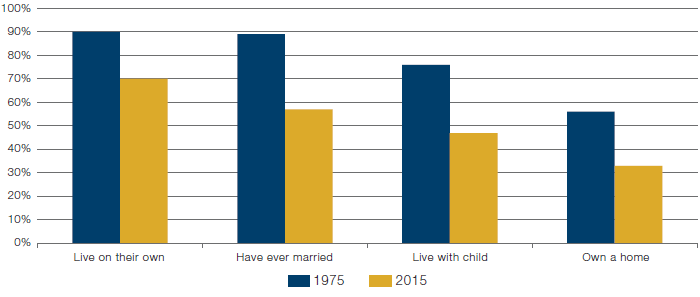
Source: US Census Bureau, John Burns Real Estate Consulting, LLC; as of December 2015 (published 2019).
Figure 5. Current US Population by Age Cohort
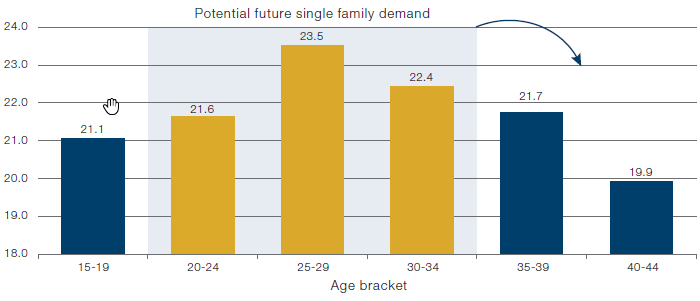
Source: US Census Bureau, Man GPM; as at July 2019.
We could therefore see something of a baby boom in the US, for which the housing market is ill-equipped to cope. As people get married and have children, they need more bedrooms. Figure 6 shows that only over a tenth of apartments have more than two bedrooms, while almost two-thirds of single family homes have in excess of two bedrooms. It would seem logical that as a baby boom takes hold, millennials are forced out of multi-family apartments and into single family homes, boosting demand for the sector.
Figure 6. Number of Bedrooms by Rental Housing Stocks
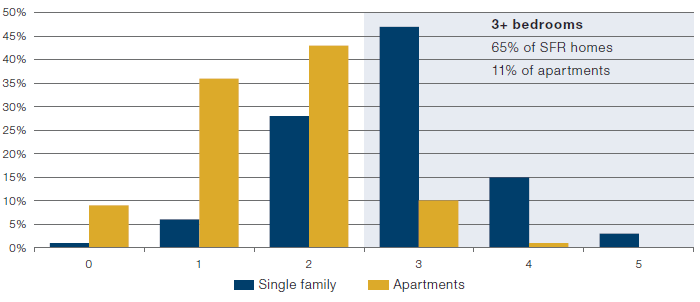
Source: JCHS tabulations of US Census Bureau, 2016 American Community Survey 1-Year Estimates, John Burns Real Estate Consulting, LLC; as of end 2017 (published December 2019). Note: Single family includes attached and detached units.
The onset of coronavirus has further augmented the positive outlook for the SFR sector: more than a third of US SFR operators are seeing an increase in rental demand since February.3 Could the coronavirus be re-shaping the underlying dynamics of the housing market? We believe the answer is yes – for both the rental and buyer market: whilst urban apartments offer advantages such as reduced commute times, their location and lack of space has made them relatively less attractive during the lockdown when compared with SFR. In a post-pandemic world, in which home working is likely to become more prevalent, the larger size, greater distance from neighbours and outdoor space offered by SFR homes will make the sector much more appealing than multi-family, in our opinion, and therefore more resilient than the wider property market.
Conclusion
Even after a decade of growth, momentum still appears to be with SFR. Housebuilding has been below average for much of that time, whilst pent-up demand, caused by delayed household formation and a growing population, is likely to be a strong tailwind for the sector. In addition, the coronavirus may create a trend of moving away from dense urban cores towards the suburbs, further supporting the SFR sector. As such, we have a positive outlook on SFR for the forseeable future.
1. Source: Colby and Ortman ‘Projections of the Size and Composition of the U.S. Population: 2014 to 2060’ published by the US Census Bureau, with the timeframes of the projections chosen by the authors.
2. Source: US Census Bureau.
3. Source: John Burns Real Estate Consulting, LLC.
You are now leaving Man Group’s website
You are leaving Man Group’s website and entering a third-party website that is not controlled, maintained, or monitored by Man Group. Man Group is not responsible for the content or availability of the third-party website. By leaving Man Group’s website, you will be subject to the third-party website’s terms, policies and/or notices, including those related to privacy and security, as applicable.